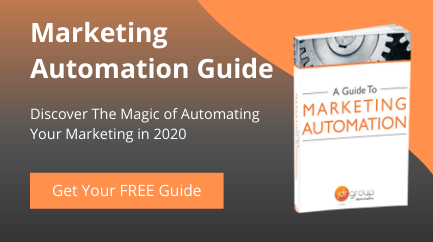5 Secrets to B2B Marketing Automation That Your Competitors Don't Know!

For B2B focused companies, marketing automation applications are becoming increasingly popular. This is true for businesses of all shapes and sizes, in all industry sectors. Recent trends show that there are nearly 11 times more B2B organisations using marketing automation now than there were five years ago.
Large companies like Amazon, Adobe and Tetra Pak spend a lot of money on their B2B marketing strategies and employ extensive in-house teams, but there is no reason smaller companies should feel like they are missing out. Using a marketing automation platform, especially in conjunction with a partner agency such as JDR, allows you to hit above your weight and compete on a level playing field with the big names in your sector.
Being successful with marketing automation is all about focusing on your leads. Below are some simple but effective ways of making sure your marketing stands out against the bigger giants.
1) Understand your market
You may feel you know your customers like the back of your hand, and you probably do. Understanding your customer’s needs and aspirations places you in a strong position when carrying out sales and relationship building. However, for marketing automation, you also need to understand how your target customers behave as leads. To do this you should make yourself aware of the benchmark standards in your industry for marketing pipeline development, conversion rate and lead scoring, amongst other things. This is important because by doing so you can establish a sales and marketing funnel that accurately reflects the different personas working in your industry and allows you to target campaigns accordingly. Knowing your leads takes the random element out of marketing and establishes your efforts on a sound foundation.
2) Build don’t buy
Many big companies tend to bulk-buy customer data; specifically email lists, which is an easy way of reaching many prospects in a short time. However, this is not necessarily the best way to go about marketing. You frequently have no means of validating the quality of purchased data. Also a purchased data list is difficult to segment into accurate buyer personas, as there has been no first hand contact made with the lead. Campaigns conducted with second-hand data may therefore yield erratic or disappointing results.
Instead of purchasing data, start with a small database of organic leads and build up from there. Take the time to get to know your market, building up relationships through carefully considered content. Soon you will build up a quality list. Old-fashioned marketing wisdom viewed activities such as email marketing is a numbers game, so the emphasis was always on having a large database, often at the expense of the quality of the leads. This has proven to be an inaccurate assessment. You are likely to get a far higher conversion rate and ROI from a small, highly segmented list then you would from a big, impersonal database.
3) Think outside the inbox
Whether you use email, phone or social media to cultivate your leads, think outside the box and take time to create meaningful content. No one wants to hear the same old sales jargon or transparent stories over and over again. If you expect to be listened to, then it is important to put yourself in your customer’s shoes and provide content that is of genuine value.
In doing this, don’t underestimate the power of interactive content. A good example of this is Mini’s social media campaign of 2015. Mini encouraged potential customers to upload photos of their car to Facebook and Twitter with the hashtag #MININOTNORMAL. The company then used people’s photos and displayed them on digital billboards across the UK. According to the Guardian, 230,000 people engaged with the campaign via social media in the space of six weeks. If you can show your target audience that you are capable of delivering this kind of content, it is bound to put you ahead of your competitors.
4) Hire the right people
Marketing automation platforms are tools; nothing more and nothing less. How they are used depends on the knowledge and time available to the people in charge of implementing them. It is therefore important to any marketing automation strategy to hire the right people to ensure your leads are nurtured, tested, analysed and developed; and that content is created, personalised and published. This will involve investment in recruitment, training and other resources, as well as software subscription costs. If you have a large HR budget and the space to house a marketing team, then now is the time to invest. However, if you are not in a position to do so, or if your capital is better spent elsewhere, then it is usually more cost-effective to work with an agency. Using ourselves as an example, our clients have access to a focused team of 30 trained marketing professionals, at a tiny fraction of the cost of employing these people directly.
5) Learn from Successful B2C Marketing Strategies
Our final point comes back round to the content you use. Generations X, Y and the Millennials are more experience-focused than the Boomers, who are arguably more focused on products. It therefore isn’t enough for your marketing content to tell your customers how much of a discount they can receive on their double glazing. Those John Lewis Christmas adverts make us cry not in anticipation of festive savings, but by the story it portrays that triggers empathy in its viewers. The products themselves are almost irrelevant.
This rule applies for all the most creative and successful advertising campaigns. Have a look on YouTube for some of the classic adverts by Levis and Xbox, for instance. They tell a story and generate an emotive response that connects the viewer to the brand. Sales follow as a result of this, but are not the primary purpose of the content. These examples come from B2C adverts, but exactly the same logic applies to B2B businesses, as you are ultimately dealing with the same people. It may not be your goal to make your customer well up with emotion, but you do want them to feel that your service makes their job easier, more fulfilling, more enjoyable and more productive. The upshot of this is that you should try to paint a picture and tell a story with all of your content, whether it is a Facebook advert, blog post, social media update, email or infographic.
A marketing automation strategy takes time and careful planning. There are no quick routes to success. To make your approach individual and relevant to the needs of your customers, don’t focus on what other companies are doing; focus on what you have to give and the tale you have to tell. You have to put your blinkers on and run your own race. For an impartial chat about marketing automation and how it can help your business grow, get in touch with one of our experts today.


